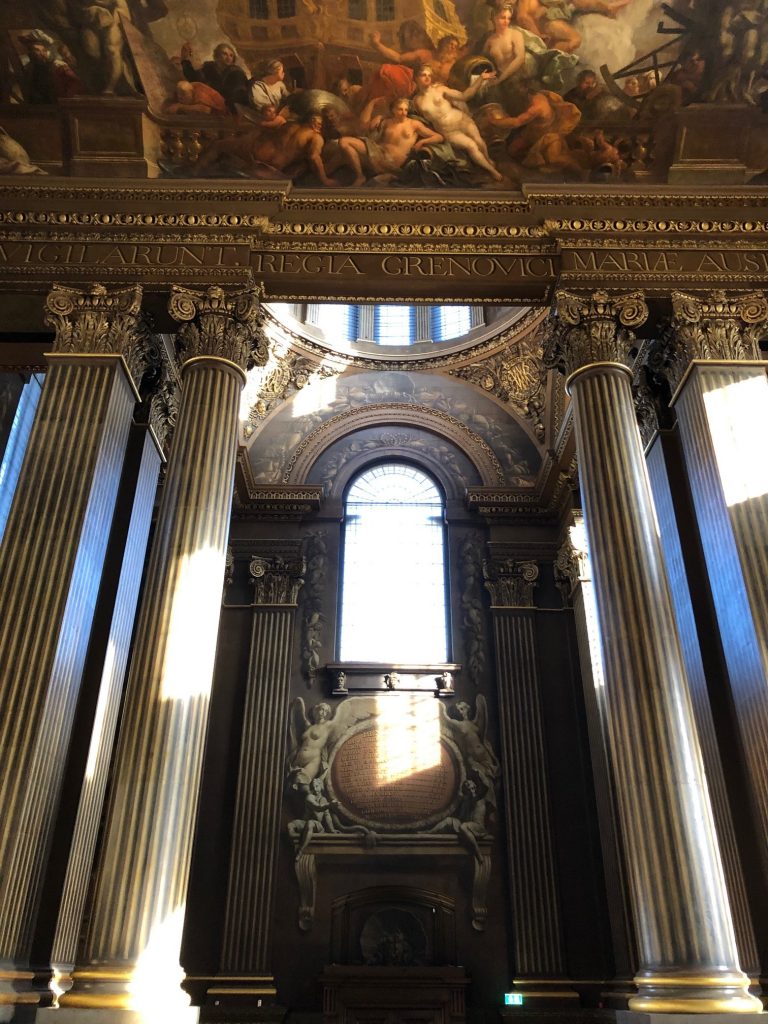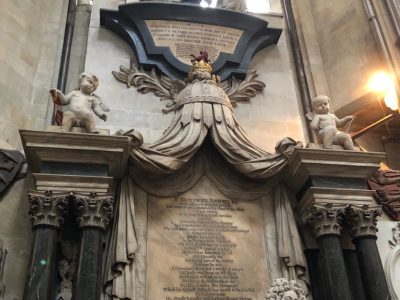
See the fabulous Painted Hall in Greenwich

The richness of the decoration on every wall of this room is unbelievable and worth every penny of the admittance fee. It reopened in 2019 after several years of renovation. During the day huge windows and rooftop oculi allow natural light to flood in and it is really looking great.
The best thing about being a guide with very little work and a lot of free time due to the Covid epidemic visiting places I usually guide and just looking. Simply taking in the fantastic sights without having to think about what I am going to say next. It’s heaven and I can see why tourists love London.
Continuing on from last week’s blog about what to see in Greenwich; one of the top sites is the Painted Hall at the Old Royal Naval College.
Background information about the building
The buildings began life as a retirement home for wounded and elderly Royal Navy sailors. it was inspired by the Royal Hospital, Chelsea built for retired soldiers.
The impetus to build it was a naval victory against Louis XIV at La Hogue in 1692. It was a victory but it resulted in many casualties. At the time, unfit men were discharged with no provision made for their future welfare. Many became beggars.
The retirement home was called Greenwich Royal Hospital for Seamen. Most of it was designed by Sir Christopher Wren. He offered his services free of charge because it was such a good cause. The hospice was built on the site of a royal palace and was completed in 1714.
The pensioner’s dining room is the Painted Hall although many felt uncomfortable in the sumptuous surroundings. They preferred to eat in the under-croft beneath. The hall soon became a place for special ceremonies and for entertaining wealthy visitors.
James Thornhill

It took the artist James Thornhill (c1676-1734) twenty years to complete. He began the work as a young, newly qualified painter. Thornhill had been apprenticed to an English artist member of the Painters & Stainers livery company in London. As an apprentice he worked with his master in many country houses. There he saw work by visiting foreign artists such Antonio Verrio and Louis Laguerre who influenced his style.
Thornhill worked on several commissions at the same time. For example, at Chatsworth House, Blenheim Palace and St Pauls Cathedral. He had a group of assistants to help him execute his designs. How much input they had is not clear.
In the recent restoration, no pounce (outlines of figures traced) so Thornhill must have drawn the shape of the figures portrayed. His assistants might have filled in parts of the drawing. Some of them are known to have had specialities. For example, Robert Brown was renowned for the way he painted drapery. Antoine Monnoyer was a flower specialist and painted the vases of flowers on the ceiling in the upper room. Another assistant, Dietrich Ernst Andreae and a lot of the work on the end wall here which depicts the Hanoverian dynasty.
The medium used is oil paint on dry plaster. Thornhill was famously paid by the yard for his work – £3 a square yard for the ceilings, and £1 a square yard for the walls. Why the price difference? Most of the walls are grisaille. The ceilings are more detailed. Apart from the discomfort of painting a ceiling, artists could only work on them in daylight. This is because smoke from candle or oil lamp flames would spoil them.
Thornhill’s fee here was less than he had asked for but he was young when he received the commission and was anxious to prove himself.
Symbols and allegories
The ceiling of the main (lower) part shows joint monarchs, William & Mary. The building project was started during their reign.
You could spend hours working out what all the allegorical figures mean. They all have a connection to mariners. There are ships carrying goods or armies, rivers and seas. The four seasons and their different weather conditions are represented. Philosophers, we would now call them scientists, whose discoveries helped sailors navigate also feature. Men like the Royal Astronomer, John Flamsteed who charted the skies at Greenwich Observatory and Copernicus who realised the earth moves around the sun.
Many of these figures have been rediscovered since the recent restoration work.


Thornhill produced a booklet, Explanation of the Painting after he completed his work. It was sold to visitors and the proceeds went to the aid of orphaned mariner’s sons who were educated in Greenwich.

In the upper room is a large crack in the plaster. The plaster here is on a wooden frame and the wood has moved slightly with time. Look closely at the female figure here. She is handing a gold staff topped by an eye to George I. Could this symbolise the masonic All-Seeing Eye of Providence? There is no record of George I being a Freemason but James Thornhill was.
If you would like to know more about the images in the Painted Hall, book a guided tour with me.
To book a guided tour of Greenwich including a visit to the Painted Hall






